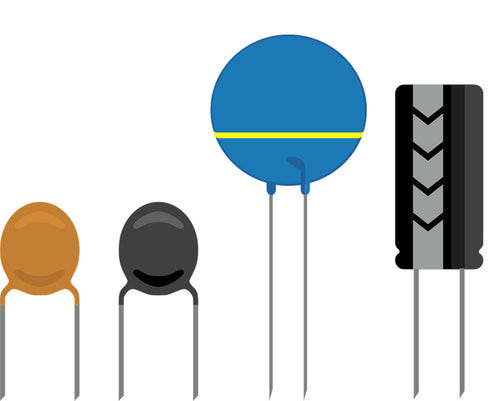Capacitors in Parallel
When capacitors are connected across each other (side by side) this is called a parallel connection. This is shown below. To calculate the total overall capacitance of a number of capacitors connected in this way you add up the individual capacitances using the following formula: CTotal = C1 + C2 + C3 and so on Example: To calculate the total capacitance for these three capacitors in parallel.
To calculate the total overall capacitance of a number of capacitors connected in this way you add up the individual capacitances using the following formula: CTotal = C1 + C2 + C3 and so on Example: To calculate the total capacitance for these three capacitors in parallel.  CTotal = C1 + C2 + C3 = 10F + 22F + 47F = 79F
CTotal = C1 + C2 + C3 = 10F + 22F + 47F = 79FTask 1:
Calculate the total capacitance of the following capacitors in parallel.
Capacitors in Series
When capacitors are connected one after each other this is called connecting in series. This is shown below. To calculate the total overall capacitance of two capacitors connected in this way you can use the following formula:
To calculate the total overall capacitance of two capacitors connected in this way you can use the following formula:
| Ctotal = | C1 x C2 | and so on |
| C1 + C2 |

Task 2:
Calculate the total capacitance of the following capacitors in series.
Three or more capacitors in series
 To calculate the total overall capacitance of three or more capacitors connected in this way you can use the following formula:
To calculate the total overall capacitance of three or more capacitors connected in this way you can use the following formula:  and so on. Example: To calculate the total capacitance for these three capacitors in series.
and so on. Example: To calculate the total capacitance for these three capacitors in series. 
Task 3:
Calculate the total capacitance of the following capacitors in series.
Answers
Task 1
1 = 232.2F 2 = 169.0F 3 = 7.0FTask 2
1 = 2.48F 2 = 14.99F 3 = 4.11FTask 3
1 = 3.33F 2 = 1.167F 3 = 0.35F Note The capacitor values in this worksheet have been kept high (close to or greater than one). This is to simplify the learning experience. In reality typical capacitor values are much smaller than one. Download a pdf version of this page here.©Kitronik Ltd – You may print this page & link to it, but must not copy the page or part thereof without Kitronik's prior written consent.








30 comments
pius official
Good tasks they have helped me
Mark Donnison
Thanks Benjamin!
Benjamin mading
This site has been helpful to many of us. Thanks kitronik!
Mark Donnison
Hi, we don't have a guide showing this at the moment, but it is something we should add. You have guessed correctly how to calculate the total capacitance for your circuit. I hope this helped.
Trish
Do you have any tasks worked out with similar images as shown above? I am trying to figure out this same problem. I have two capacitors parallel to each other but also in a series with one other capacitor. Would I add the two in parallel and then use that number in the equation for the series? Any advice is helpful thank you!!
Precious E
This has really helped me so thanks a lot
Mustapha Abubakar
I LIKE THIS CALCULATION SO MUCH
Vijay
Very good information thank you kitronik
Mark Donnison
Hi Emmanuel, You can work out the capacitance of each of the areas individually and then work out how to find the total capacitance, the method would be determined by how the different areas are arranged in relation to each other. They may be in series with each other or in parallel. I hope this helps.
Emmanuel
How do I work out capacitors connected in both parallel and series
james mcgahan
this is a very useful tool for my studies in electrical fundamentals. thanks
Mark Donnison
Hi Kean, there is still one more step of your calculation left to do, you need to divide 1 by 3 and then you will have your answer for C total. Hope this helps.
Kean Sakata
The formula for series capacitance does not work for 1F. If you add 1+1+1 you get 3F instead of .333F. Please explain.
Virat kohli
Very very helpful site I like it.. Being a student of class 10th I understood it to how to solve the question of series and parallel combinations of conductors..
Mufti
I love this Site. Thank you very much, i am going to write exams. now my problem on capacitors has been solved totally. thank you once again
Mark Donnison
This may be something that we produce a resource for at some point but for now, try google as there is already a lot of information on this online.
mbasinya Markus
I need more explanation about COULOUMBS LAW OF ELECLECTROSTATICS, and ITS CALCULATION.
Aloice Amboso
I like this site it really help me
Lilian
Awwnnn….it really amazing it helps alot.
Auwal idris
wow!! i really luv this site it is very helpfull.
olubowale olajumoke
My problem on capacitor are solve
Samweli Masalu
Hi i like this calculation of series and parallel
Mark Donnison
Hi Douglas, The calculation examples will work regardless of the values of the individual capacitors.
Douglas West
Hi, It appears that your examples deal only in capacitors of varying capacitance. It would be useful to include examples of identical capacitors connected in series and parallel. Series Connected Identical Capacitors….. Total Capacitance= Nominated Capacitance divided by Total number of Capacitors. EG.. 3000 Farad ÷(X5 in series), …3000F/5=600F. Parrallel Connected Identical Capacitors…… Total Capacitance=Nominated Capacitance Times Total Number of Capacitors………. 3000Farad X (X5 in parallel)…3000FX5=15,000F Does away with all the “Long Division Nonsense”
Rob Haywood
Hi, The voltage would remain the same. Rob
Haruna Ibrahim
The explanation is clear, but what about the working voltage of two capacitors in parallel? Does it remains the same or individual capacitor voltage rating is added up. Suppose both capacitors are the same working voltage rating
Belko King Solomon
this explanation is simple and easy to understand and like it.
Arne Risy
So far this is the only explanation I've been able to understand. Thanks
Rob Haywood
Thanks, I've corrected that now!
k
i think task 3 is suppose to be 1.167F not 1.67F